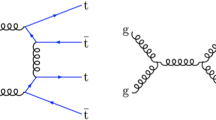Abstract
Two hundred cases of meson decay have been studied in order to verify if, beyond the known type of decay of the \(\pi ^+\) meson in a light \(\mu\) meson and a neutrino, a different type of disintegration of the \(\pi ^+\) meson directly in one positive electron and a neutrino (which is theoretically possible) should be observed and, if so, what should be the probability of occurrence of such a process. The \(\pi ^+\) mesons studied have been produced by bombarding targets of carbon with protons of 350 MeV in the cyclotron of 184 inches, at the Radiation laboratory, in Berkeley, and have been detected with nuclear emulsions G.5. Associating the method of mass determination by the range and the radius of curvature, with the method of grain counting, it has been possible to verify that, in the 200 cases under examination, all the mesons decayed following the scheme: \(\pi ^+ \rightarrow \mu ^+ + [ \nu ]\). During the investigation a system of three tracks departing from the same point has been observed, which is probably a “star” of three branches, produced by the capture of a high energy neutron by a nucleus of the emulsion. One of the branches is due to a meson which decays in a \(\mu\) meson whose track is totally observed and ends in the emulsion.










Similar content being viewed by others
References
S.H. Neddermeyer, C.D. Anderson, Phys. Rev. 51, 884 (1937)
J.C. Street, E.C. Stevenson, Minutes of the Washington Meeting Am. Phys. Soc., - April 1937, Phys. Rev. 51, 1005 (1937)
C.M.G. Lattes, H. Muirhead, G.P.S. Occhialini, C.F. Powell, Nature 159, 694 (1947)
C.M.G. Lattes, G.P.S. Occhialini, C.F. Powell, Nature 160, 453–486 (1947)
R.B. Leighton, C.D. Anderson, C.M.G. Lattes, Phys. Rev. 75, 1466 (A) (1949)
E. Gardner, A.S. Bishop, A.J. Seriff, Phys. Rev. 75(1432), 1468 (1949)
H. Nereson, B. Rossi, Phys. Rev. 64, 199 (1943)
E.A. Martinelli, W.K.H. Panofsky, Phys. Rev. 77, 465 (1950)
Steiberger, Panofsky, private communication
H.L. Bradt, M.F. Kaplon, B. Peters, Helv. Phys. Acta 23, 24 (1950)
R. Brown, U. Camerini, P.H. Fowler, H. Muirhead, C.F. Powell, Nature 163(47), 82 (1949)
L. Leprince-Ringuet, M.J. L’Heritier, J. Phys, et. Rad., 7, 66 (1946)
G.D. Rochester, C.C. Butter, Nature 160, 856 (1947)
L. Leprince-Ringuet, C. Peyrou, J. Phys, et. Rad., 11, 243 (1950)
L. Leprince-Ringuet et al., C. R. Acad. Sci. (Paris) 226, 1897 (1948)
C.M.G. Lattes, private communication
J. Burfening, E. Gardner, C.M.G. Lattes, Phys. Rev. 75, 382 (1949)
E. Gardner, C.M.G. Lattes, Science 107, 270 (1948)
F.M. Smith, W.H. Barkas, A.S. Bishop, H. Bradner, E. Gardner, Bul. Am. Phys. Soc. 24(8), 9 (1949)
Acknowledgements
We are thankful to Prof. Cesar Lattes, who suggested the present work, following and discussing it with interest; to Prof. J. Costa Ribeiro from Departamento de Física da Faculdade Nacional de Filosofia for his valuable help, to whom we own the mosaic of photomicrographs corresponding to the criation of the \(\pi ^+\) meson in the emulsion; to Dr. Hugh Bradner, for exposing and treating the plates; and to the head of Instituto de Química Agrícola, Dr. Fleury de Amorin, for lending the microscopes used in the plates examination. We also thank Foto-Produtos do Brasil S.A. for kindly offer the “Microgran” films used in the photomicrographs.
Author information
Authors and Affiliations
Additional information
Publisher’s Note
Springer Nature remains neutral with regard to jurisdictional claims in published maps and institutional affiliations.
This article is a translated version of Elisa Frota-Pessoga and Neusa Margem, Sobre a desintegracao do megson pesado positivo. An Acad Bras Cienc September (1950), vol. 22; 371-383 (with permission from the Anais da Academia Brasileira de Ciências).
The Foreword to this article can be found at https://doi.org/10.1007/s13538-021-00986-5.
Rights and permissions
About this article
Cite this article
Frota Pessoa, E., Margem, N. On the Disintegration of the Positive Heavy Meson. Braz J Phys 51, 1492–1500 (2021). https://doi.org/10.1007/s13538-021-00987-4
Received:
Published:
Issue Date:
DOI: https://doi.org/10.1007/s13538-021-00987-4




